High Impact Tutoring Built By Math Experts
Personalized standards-aligned one-on-one math tutoring for schools and districts
In order to access this I need to be confident with:
Volume Volume formula Volume of a prism Volume of a cubeVolume of a cylinder
Here you will learn about the volume of a cylinder, including how to calculate the volume of a cylinder given its radius, area and perpendicular height.
Students will first learn about volume of cylinders as part of geometry in grade 7 and again in grade 8 and high school geometry.
What is the volume of a cylinder?
The volume of a cylinder is the amount of space there is inside a cylinder.
In order to find the volume of a cylinder you first need to find the circular area of the base.
To do this, you can use the formula for calculating the area of a circle, which is
\text { Area }=\pi r^2.Then multiply the area of the circular base by the height (or length) of the cylinder.
To do this, you can use the formula for the volume of a cylinder, which is
\text { Volume }=\pi r^2 h.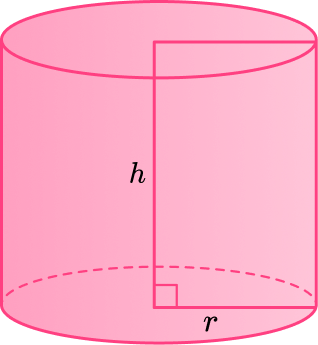
Where \textbf{r} is the radius of a cylinder and \textbf{h} is the perpendicular height of a cylinder.
For example, find the volume of this cylinder with radius of the base 7~cm and perpendicular height 10~cm.
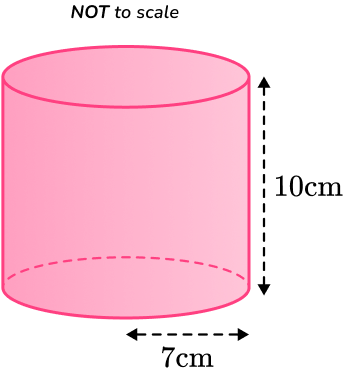
What is the volume of a cylinder?
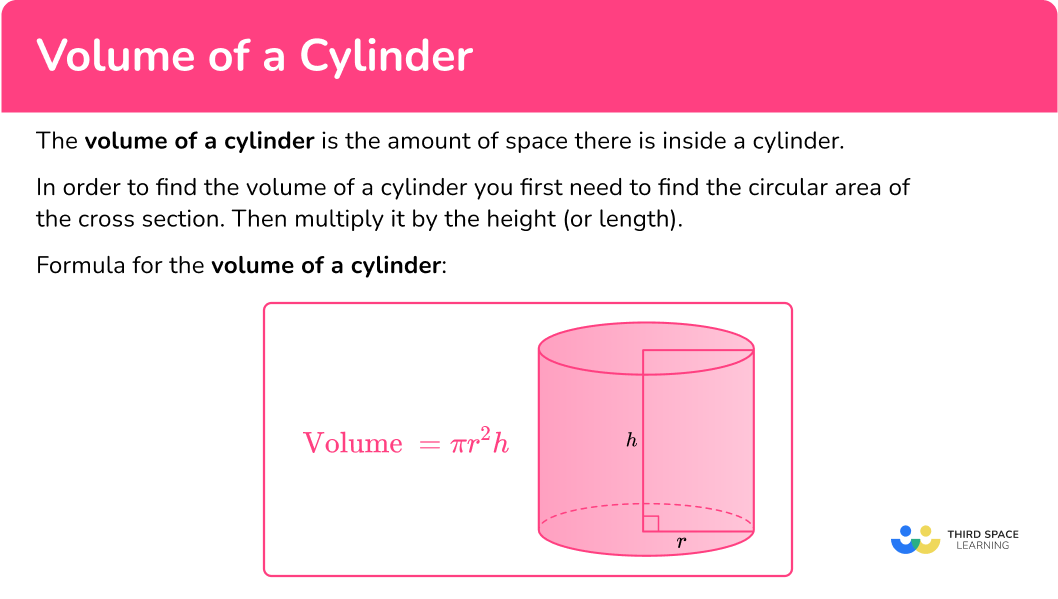
Common Core State Standards
How does this relate to 7 th grade and high school math?
- Grade 7 – Geometry (7.G.B.6)
Solve real-world and mathematical problems involving area, volume and total surface area of two- and three-dimensional objects composed of triangles, quadrilaterals, polygons, cubes, and right prisms.
- High School – Geometry (HSG.GMD.A.3)
Use volume formulas for cylinders, pyramids, cones, and spheres to solve problems.
![[FREE] Volume Of A Cylinder Worksheet (Grade 7)](https://thirdspacelearning.com/wp-content/uploads/2025/01/Volume-Of-A-Cylinder-Worksheet-listing-image.png)
[FREE] Volume Of A Cylinder Worksheet (Grade 7)
![[FREE] Volume Of A Cylinder Worksheet (Grade 7)](https://thirdspacelearning.com/wp-content/uploads/2025/01/Volume-Of-A-Cylinder-Worksheet-listing-image.png)
Use this worksheet to check your 7th grade students’ understanding of volume of a cylinder. 15 questions with answers to identify areas of strength and support!
DOWNLOAD FREE![[FREE] Volume Of A Cylinder Worksheet (Grade 7)](https://thirdspacelearning.com/wp-content/uploads/2025/01/Volume-Of-A-Cylinder-Worksheet-listing-image.png)
[FREE] Volume Of A Cylinder Worksheet (Grade 7)
![[FREE] Volume Of A Cylinder Worksheet (Grade 7)](https://thirdspacelearning.com/wp-content/uploads/2025/01/Volume-Of-A-Cylinder-Worksheet-listing-image.png)
Use this worksheet to check your 7th grade students’ understanding of volume of a cylinder. 15 questions with answers to identify areas of strength and support!
DOWNLOAD FREEHow to calculate the volume of a cylinder
- Write down the formula: \text{Volume} = \pi r^2 h
- Substitute the given values.
- Work out the calculation.
- Write the final answer, including units.
Volume of a cylinder examples
Example 1: volume of a cylinder
Find the volume of the cylinder with radius 3~cm and perpendicular height 5~cm.
Give your answer to 1 decimal place.
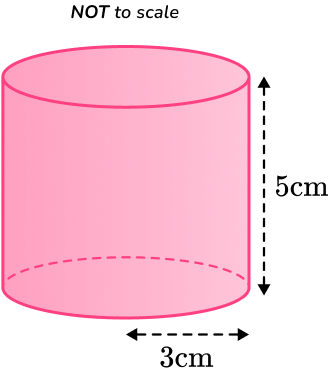
- Write down the formula.
To answer the question you need the formula for the volume of a cylinder.
\text { Volume }=\pi r^2 h2Substitute the given values.
Substitute the value of the radius r and the perpendicular height h into the formula.
V=\pi \times 3^2 \times 53Work out the calculation.
Use a calculator to work out the volume.
V=45 \pi=141.3714Write the final answer, including units.
Check what form the final answer needs to be written in. You may need to leave your answer in terms of \pi or as a decimal with rounding. Here you are asked to give the answer to 1 decimal place.
V=141.371=141.4 \mathrm{~cm}^3The volume of the cylinder is: 141.4 \mathrm{~cm}^3.
Example 2: volume of a cylinder
Find the volume of the cylinder with radius 4.8~cm and perpendicular height 7.9~cm.
Give your answer to 3 significant figures.
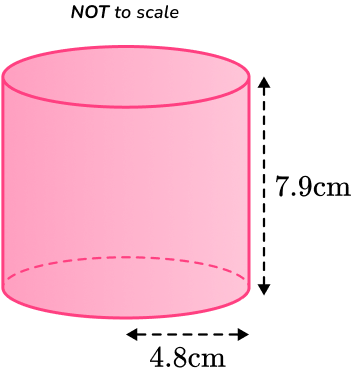
Write down the formula.
To answer the question you need the formula for the volume of a cylinder.
\text { Volume }=\pi r^2 h
Substitute the given values.
Substitute the value of the radius r and the perpendicular height h into the formula.
V=\pi \times 4.8^2 \times 7.9
Work out the calculation.
Use a calculator to work out the volume.
V=571.820
Write the final answer, including units.
Check what form the final answer needs to be.
You may need to leave your answer in terms of \pi or as a decimal with rounding.
Here you are asked to give the answer to 3 significant figures.
V=571.820=572 \mathrm{~cm}^3
The volume of the cylinder is: 572 \mathrm{~cm}^3.
Example 3: volume of a cylinder
Find the volume of the cylinder with radius 3~cm and perpendicular height 7~cm.
Leave your answer in terms of \pi.
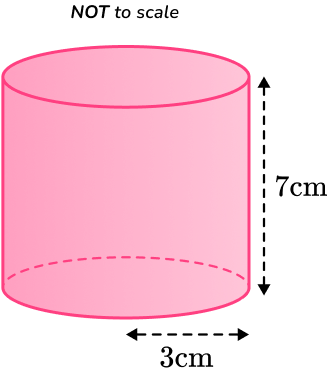
Write down the formula.
To answer the question you need the formula for the volume of a cylinder.
\text { Volume }=\pi r^2 h
Substitute the given values.
Substitute the value of the radius r and the perpendicular height h into the formula.
V=\pi \times 3^2 \times 7
Work out the calculation.
Work out the volume. (Focusing on the number parts of the calculation).
V=63 \pi
Write the final answer, including units.
Check what form the final answer needs to be written in. You may need to leave your answer in terms of \pi or as a decimal with rounding.
V=63 \pi=63 \pi \mathrm{~cm}^3
The volume of the cylinder is: 63 \pi \mathrm{~cm}^3.
Example 4: volume of a cylinder
Find the volume of the cylinder with radius 4~cm and perpendicular height 10~cm.
Leave your answer in terms of \pi.
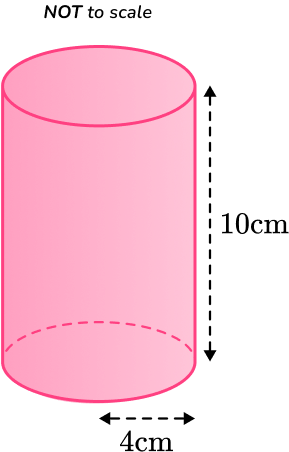
Write down the formula.
To answer the question you need the formula for the volume of a cylinder.
\text { Volume }=\pi r^2 h
Substitute the given values.
Substitute the value of the radius r and the perpendicular height h into the formula.
V=\pi \times 4^2 \times 10
Work out the calculation.
Work out the volume. (Focusing on the number parts of the calculation).
V=160 \pi
Write the final answer, including units.
Check what form the final answer needs to be.
You may need to leave your answer in terms of \pi or as a decimal with rounding.
V=160 \pi=160 \pi \mathrm{~cm}^3
The volume of the cylinder is: 160 \pi \mathrm{~cm}^3.
Example 5: using the formula to find a length
The volume of a cylinder is 1600~cm^3. Its radius is 9~cm. Find its perpendicular height. Give your answer to 2 decimal places.
Write down the formula.
The question involves the volume of a cylinder, so you need the formula for the volume of a cylinder.
V=\pi r^2 h
Substitute the given values.
You are given the volume and the radius, so substitute these into the formula.
1600=\pi \times 9^2 \times h
Work out the calculation.
You need to rearrange the formula to find the value of h.
1600=\pi \times 81 \times h
\cfrac{1600}{\pi \times 81}=h
h=6.287
Write the final answer, including units.
Check what form the final answer needs to be.
You may need to leave your answer in terms of \pi or as a decimal with rounding.
Here you are asked to give the answer to 2 decimal places.
h=6.287=6.29 \mathrm{~cm}
The perpendicular height of the cylinder is: 6.29~cm.
Example 6: using the formula to find a length
The volume of a cylinder is 1400~cm^3. Its perpendicular height is 15~cm. Find its radius. Give your answer to 2 decimal places.
Write down the formula.
The question involves the volume of a cylinder, so you need the formula for the volume of a cylinder.
V=\pi r^2 h
Substitute the given values.
You are given the volume and the perpendicular height, so substitute these into the formula.
1400=\pi \times r^2 \times 15
Work out the calculation.
You need to rearrange the formula to find the value of h.
1400=\pi \times r^2 \times 15
\cfrac{1400}{\pi \times 15}=r^2
r^2=29.70892
r=\sqrt{29.70892}
Write the final answer, including units.
Check what form the final answer needs to be written in.
You may need to leave your answer in terms of \pi or as a decimal with rounding.
Here you are asked to give the answer to 2 decimal places.
r=\sqrt{29.70892}=5.4505=5.45 \mathrm{~cm}
The radius of the cylinder is: 5.45~cm.
Teaching tips for volume of a cylinder
- Implement engaging visual aids and real-world examples to illustrate how the formula applies, fostering a deeper comprehension of 3d shapes. Using visual aids will also help English Language Learners comprehend the complexity of the three dimensional space and three-dimensional shapes.
- Incorporate interactive activities and group exercises that encourage hands-on exploration of cylinder volume calculations, ensuring students actively participate in the learning process. Incorporating open-ended tasks for students to find the surface area of a cylinder, cuboid, or oblique cylinder as well as a focus on the area of the cylinder and base of the cylinder will scaffold student learning appropriately.
- Provide step-by-step problem-solving tutorials, addressing common challenges students might encounter when finding the volume of a cylinder, thereby enhancing the accessibility and usefulness of your educational content.
- Highlight the importance of exposing students to diverse cubic units such as cubic inches, cubic centimeters, cubic meters, and cubic feet, as it not only reinforces the concept of volume but also fosters a versatile and practical comprehension of three-dimensional space.
Easy mistakes to make
- Incorrect radius calculation
When finding the volume of a cylinder, be cautious not to miscalculate the radius, as errors in this fundamental measurement can lead to inaccuracies in the final volume. Emphasize the importance of doubling the radius squared and verify calculations to prevent mistakes.
- Misinterpreting height measurements
Avoid the mistake of misinterpreting or inaccurately measuring the height of the cylinder. Stress the need for precision in obtaining height values, and remind students to double-check measurements to ensure accuracy in volume calculations.
- Omitting units in the final answer
In the excitement of solving volume problems, it’s easy to overlook including the appropriate units in the final answer. Remind students to always attach the correct cubic units (cubic inches, cubic centimeters, cubic feet, cubic meters, etc.) to their volume results, enhancing clarity and correctness.
- Neglecting the order of operations
Students may inadvertently neglect the proper order of operations when applying the volume formula. Reinforce the importance of parentheses and guiding students to follow the correct sequence to prevent errors in their calculations.
- Overlooking the \textbf{P}\,\textbf{i} value
Students may forget to incorporate the value of Pi accurately, leading to significant errors in volume calculations. Stress the consistent use of the correct \pi value and caution against rounding too early in the calculation process to maintain precision in results.
Practice volume of a cylinder questions
1) Find the volume of a cylinder with a radius 3.2~cm and perpendicular height 9.1~cm. Give your answer to 3 significant figures.
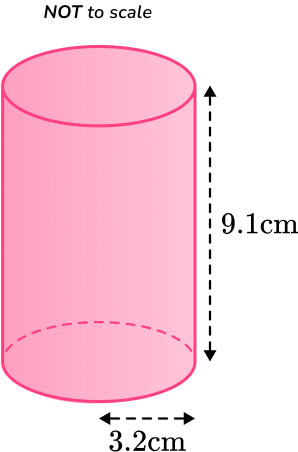




You are finding the volume of a cylinder so substitute the value of r and h into the formula.
\begin{aligned} V&=\pi r^2 h\\\\ V&=\pi \times 3.2^2 \times 9.1\\\\ V&=292.746\\\\\ V&=293 \ cm^3 \end{aligned}
2) Find the volume of a cylinder with a radius 5.3~cm and perpendicular height 3.8~cm. Give your answer to 3 significant figures.
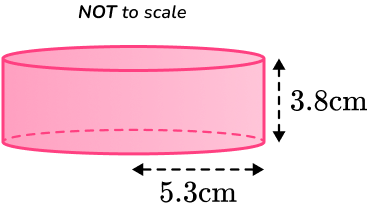




You are finding the volume of a cylinder so substitute the value of r and h into the formula.
\begin{aligned} V&=\pi r^2 h\\\\ V&=\pi \times 5.3^2 \times 3.8\\\\ V&=335.339\\\\ V&=335 \ cm^3 \end{aligned}
3) Find the volume of a cylinder with a radius 8~cm and perpendicular height 7~cm. Leave your answer in terms of \pi.
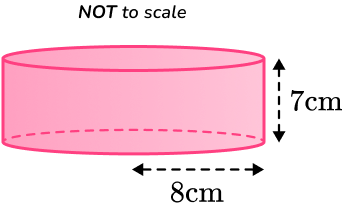




You are finding the volume of a cylinder so substitute the value of r and h into the formula.
\begin{aligned} V&=\pi r^2 h\\\\ V&=\pi \times 8^2 \times 7\\\\ V&=448\pi\\\\ V&=448\pi \ cm^3 \end{aligned}
4) Find the volume of a cylinder with a radius 4~cm and perpendicular height 8~cm. Give your answer to 3 significant figures.
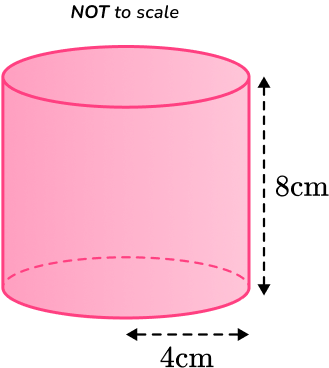




You are finding the volume of a cylinder so substitute the value of r and h into the formula.
\begin{aligned} V&=\pi r^2 h\\\\ V&=\pi \times 4^2 \times 8\\\\ V&=402.1238 \\\\\ V&=402 cm^3 \end{aligned}
5) The volume of a cylinder is 250~cm^3. Its radius is 2.9~cm. Find its perpendicular height. Give your answer to 2 decimal places.




Using the formula, substitute the value of the volume and the value of the radius and rearrange to find the radius.
\begin{aligned} V&=\pi r^2 h \\\\ 250&=\pi \times 2.9^2 \times h\\\\ \cfrac{250}{\pi \times 2.9^2}\,&=h\\\\ h&=9.4622\\\\ h&=9.46 \ cm \end{aligned}
6) The volume of a cylinder is 800~cm^3. Its perpendicular height is 9.2~cm. Find its radius. Give your answer to 2 decimal places.




Using the formula, substitute the value of the volume and the value of the perpendicular height and rearrange to find the radius.
\begin{aligned} V&=\pi r^2 h\\\\ 800&=\pi \times r^2 \times 9.2\\\\ \cfrac{800}{\pi \times 9.2}\,&=r^2\\\\ r&=\sqrt{\cfrac{800}{\pi \times 9.2}}\\\\ r&=5.2610\\\\ r&=5.26 \ cm \end{aligned}
Volume of a cylinder FAQs
Common mistakes include misinterpreting height measurements, miscalculating the radius, and omitting units. Learn to recognize and avoid these errors for accurate volume calculations. Additionally, double-check your calculations and ensure you follow the correct order of operations.
Yes, you can use various cubic units, such as cubic inches or cubic centimeters, when calculating cylinder volume. Understanding different units provides versatility in solving real-world problems. Be consistent with your unit usage to maintain precision in your answers.
Ensure accuracy by consistently using the appropriate Pi value throughout your calculations. Maintain precision by avoiding premature rounding in the process. Remember to keep \pi in your calculations until the final step for accurate results.
Engage in hands-on activities like measuring the volume of cylindrical objects such as cans or jars. These real-world examples enhance your grasp of the volume formula and its applications. Experiment with various objects to reinforce the concept and its practical implications in different scenarios.
The next lessons are
- Surface area
- Pythagorean theorem
- Trigonometry
Still stuck?
At Third Space Learning, we specialize in helping teachers and school leaders to provide personalized math support for more of their students through high-quality, online one-on-one math tutoring delivered by subject experts.
Each week, our tutors support thousands of students who are at risk of not meeting their grade-level expectations, and help accelerate their progress and boost their confidence.

Find out how we can help your students achieve success with our math tutoring programs.
[FREE] Common Core Practice Tests (3rd to 8th Grade)
Prepare for math tests in your state with these 3rd Grade to 8th Grade practice assessments for Common Core and state equivalents.
Get your 6 multiple choice practice tests with detailed answers to support test prep, created by US math teachers for US math teachers!